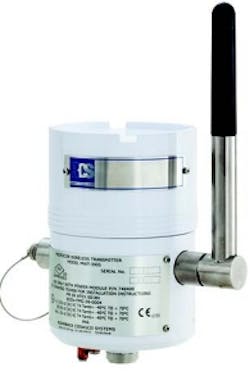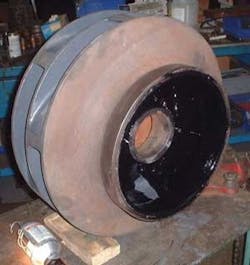Coatings Can Improve Pump Impeller Cavitation Damage Resistance
By Allan R. Budris
The writer's February 2012 WaterWorld column discussed how various impeller materials impact cavitation damage and pump life, with a brief reference to hard ceramic coatings. However, the issue of impeller coatings for either repair and/or increased resistance to cavitation damage is a complex issue that deserves more coverage, which this column attempts to address. A cavitation resistant coating could be a lower cost, better option than changing to a cavitation resistant material, such as stainless steel.
Techniques available for cavitation damage repair and/or prevention include: weld overlays and inlays, plasma sprays, thermal sprays (such as Stellite 6), reinforced epoxy coatings, unreinforced polyurethane coatings, and ceramic coatings. Ideally, the material used to repair/prevent cavitation damage should be selected to minimize capital costs, while maximizing the service life, under the expected operating conditions.
In the past, the most commonly used method, which produced the most durable coatings, used weld overlay techniques. However, weld overlays are expensive and required a high skill level. Instead, this column focuses on the more affordable polymer coatings, such as (ceramic) reinforced epoxies (which have also been used widely) and unreinforced polyurethane (which have superior cavitation resistance). Compared with a weld overlay technique, the advantages of epoxy and polyurethane compound coatings include: (1) significantly reduced labor costs, (2) avoidance of thermally-induced residual stresses in the repaired components, and (3) improved control of component contours through the use of templates.
Reinforced Epoxy Coatings
To improve wear resistance, epoxy coatings are mixed with hard-ceramic particles of alumina, silicon carbide, or the likes. Although reinforced epoxies have enjoyed some success with low intensity cavitation, it is difficult to predict their performance. The average life of epoxy coatings has been found to be relatively short, from 6 months to 1 year. Since the bond strength between the epoxy and metallic substrate depends on the surface condition, over time, the repair compounds may fail due to cavitation and mechanical fatigue of the bond interface. However, epoxy coating can be quite effective in replacing worn away metal surfaces during a repair.
Polyurethane Coatings
Although polyurethane coatings are available in both reinforced and non-reinforced versions, only flexible unreinforced polyurethane (elastomer) coatings have been found to be significantly more resistant to the effects of cavitation. Several coating manufacturers (Belzona and Metaline) have developed such coatings. These unreinforced elastomeric coatings retain adhesion under long term immersion, dissipating energy created under medium to high intensity cavitation conditions, and also provide outstanding resistance to erosion/ corrosion.
Laboratory and field tests show cavitation performance superior to stainless steel and much better than carbon steel and cast iron. Substrate surface preparation is key to assuring that the coating will exhibit the required long term adhesion under cavitating conditions.
The reason that elastomer, unreinforced polyurethane coated metal can perform better than some metals is that it can dissipated the cavitation energy, while avoiding the permanent deformations in the metal in the form of rough pitting (which typifies cavitation). The surface of the elastomer coating acts like a spring when impacted by the imploding microjets of the cavitation bubbles. This energy will produce a given displacement of the surface which is linearly proportional to the spring constant of the elastomer. As long as this displacement does not exceed the elastic limit of the elastomer, it will revert to its original shape and not suffer any adverse effects other than a miniscule increase in temperature which is rapidly rejected to the fluid.
Belzona modified one of its unreinforced polyurethane, durable, and abrasion resistant elastomers coatings to make it more suitable for cavitation service. The resulting cavitation resistant coating (Belzona 2141) has performed very well in both controlled laboratory tests and field installations.
One such field application involved an ITT Goulds 3480 double suction pump impeller, which was rebuilt at a pump workshop. This impeller was regularly being replaced at a cost of $5,000 because of very severe cavitation, which was destroying it every 3 months. After two coats of a reinforced epoxy coating (Belzona 1321) to rebuild the worn surfaces, it was coated with a final coat of Belzona 2141 at a total cost of $1,650, including labor. After 30,000 hours of continuous operation (41 months) the impeller was inspected and found to be 98% intact. The tiny defects that needed repaired were from solids that had gotten through holes in the strainer. The customer is extremely happy so far with the Belzona 2141 coating. Over the 41 month run, the coating produced a savings of $68,350.
Hydraulic Cautions
Whenever any coating is applied to the inlet of an impeller, care must be taken to insure that the coating thickness does not significantly increase the thickness of the leading edges of the impeller vanes, or markedly reduce the inlet throat area between the impeller vanes. Thicker vane leading edges and/or smaller inlet throat areas will increase the velocities at the impeller inlet, which increases the pump NPSHR and results in more cavitation. This additional cavitation can lead to increased damage, if the pump "Suction Energy" is high enough (see October 2007 column). Any such significant increase in cavitation could counter the benefits of the cavitation resistant coating. These repairs should also retain the original impeller vane shape to avoid negative impacts on the pump performance. A small change in impeller vane shape can have a relatively large affect on the head, capacity, efficiency and/or NPSHR of a pump. Generally the larger the pump the less it will be affected by the thickness of a coating.
Conclusions
When a centrifugal pump experiences premature damaging cavitation, and the Net Positive Suction Head Available (NPSHA) cannot be significantly increased, there are still options available. These options include more cavitation resistant impeller materials, and various metal and polymer coatings. The most cost effective / cavitation resistant coatings appear to fall in the unreinforced polyurethane, elastomer family. Polymer coatings can also slightly increase overall pump efficiency. The writer's May 2008 column, gives a field example of how polymer coatings can be used to repair worn pump casings and increase their efficiency.
References
1. "Do Coatings Protect against Corrosion and Wear?", Bernd Schramm, Anja Dwars & Andreas Kuhl, Techno Digest No. 10, December 2004.
2. "Application of Thermal Spray and Ceramic Coatings and Reinforced Epoxy for Cavitation Damage Repair of Hydroelectric Turbines and Pumps", Richard Ruzga, Paul Willis & Ashok Kumar, USACERL Technical Report FM-93/0, March 1993.
About the Author: Allan R. Budris, P.E., is an independent consulting engineer who specializes in training, failure analysis, troubleshooting, reliability, efficiency audits and litigation support on pumps and pumping systems. With offices in Washington, NJ, he can be contacted via e-mail at [email protected].
More WaterWorld Current Issue Articles
More WaterWorld Archives Issue Articles


